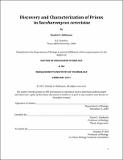| dc.contributor.advisor | Susan L. Lindquist. | en_US |
| dc.contributor.author | Halfmann, Randal A. (Randal Arthur) | en_US |
| dc.contributor.other | Massachusetts Institute of Technology. Dept. of Biology. | en_US |
| dc.date.accessioned | 2011-05-09T14:01:48Z | |
| dc.date.available | 2011-05-09T14:01:48Z | |
| dc.date.copyright | 2011 | en_US |
| dc.date.issued | 2011 | en_US |
| dc.identifier.uri | http://hdl.handle.net/1721.1/62618 | |
| dc.description | Thesis (Ph. D.)--Massachusetts Institute of Technology, Dept. of Biology, 2011. | en_US |
| dc.description | This electronic version was submitted by the student author. The certified thesis is available in the Institute Archives and Special Collections. | en_US |
| dc.description | Cataloged from student-submitted PDF version of thesis. Vita. | en_US |
| dc.description | Includes bibliographical references. | en_US |
| dc.description.abstract | Some protein aggregates can perpetuate themselves in a self-templating protein-misfolding reaction. These aggregates, or prions, are the infectious agents behind diseases like Kuru and mad-cow disease. In yeast, however, prions act as epigenetic elements that confer heritable alternative phenotypes. Prion-forming proteins create bistable molecular systems whose semi-stochastic switching between functional states increases phenotypic diversity within cell populations. My thesis work explores the idea that rather than being detrimental, prions may commonly act to their host's advantage. To broaden the known range of prion phenomena in S. cerevisiae, I, together with a postdoctoral fellow in our lab, systematically surveyed the yeast proteome for prion-forming proteins. Using a combination of computational, cell biological, and biochemical approaches, we ultimately identified 18 novel prion domains capable of driving phenotypic switching, and an additional 6 domains that were highly positive for prion-like aggregation in other assays. These results establish the critical importance of intrinsic amyloid-forming tendencies for prion behavior by Q/N-rich proteins. We further confirmed that one of these proteins, the transcription factor Mot3, forms a novel prion in its endogenous context. An analysis of these findings revealed a strong and unexpected amino acid bias in prionogenic proteins: prions were strongly enriched for asparagine (N), but not the chemically related amino acid glutamine (Q). We validated this finding using molecular simulations and experimental analyses of Q-to-N and N-to-Q variants of prion domains. N-rich sequences had an intrinsic tendency to both nucleate and propagate amyloid conformers. Q-rich proteins tended instead to make structurally non-constrained interactions leading to proteotoxic soluble and non-amyloid aggregated conformers. The appendices include works in progress. Each explores a different aspect of prion biology. Appendix A confirms a theoretical prediction that prions, if functional, should preferentially regulate certain rapidly evolving genes. I demonstrate with the newly discovered prion protein, Mot3, that prions accelerate the appearance of new phenotypes in important traits like mating behavior and cell-adhesion. I further identify naturally occurring prion states of Mot3 and other prion proteins in wild yeast isolates, and show that elimination of these prions has strong phenotypic effects in these strains. Appendix B, work done in collaboration with another lab, establishes that Nup100, a GLFG nucleoporin, is a prion. The conformational flexibility of GLFG nucleoporins is critical for the function of the nuclear pore complex, a molecular sieve that regulates all macromolecular transport between the nucleus and cytoplasm. | en_US |
| dc.description.statementofresponsibility | by Randal A. Halfmann. | en_US |
| dc.format.extent | 187 p. | en_US |
| dc.language.iso | eng | en_US |
| dc.publisher | Massachusetts Institute of Technology | en_US |
| dc.rights | M.I.T. theses are protected by
copyright. They may be viewed from this source for any purpose, but
reproduction or distribution in any format is prohibited without written
permission. See provided URL for inquiries about permission. | en_US |
| dc.rights.uri | http://dspace.mit.edu/handle/1721.1/7582 | en_US |
| dc.subject | Biology. | en_US |
| dc.title | Discovery and characterization of prions in Saccharomyces cerevisiae | en_US |
| dc.title.alternative | Discovery and characterization of prions in S. cerevisiae | en_US |
| dc.type | Thesis | en_US |
| dc.description.degree | Ph.D. | en_US |
| dc.contributor.department | Massachusetts Institute of Technology. Department of Biology | |
| dc.identifier.oclc | 719368135 | en_US |
